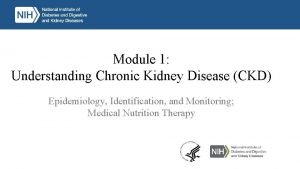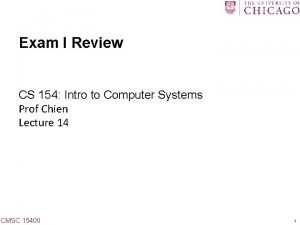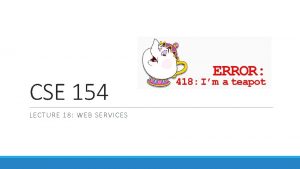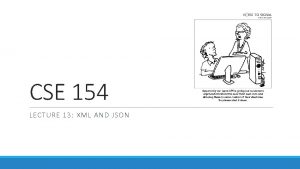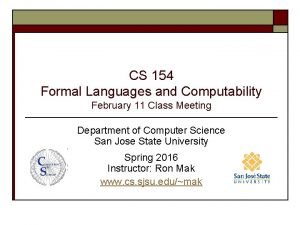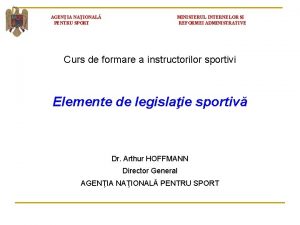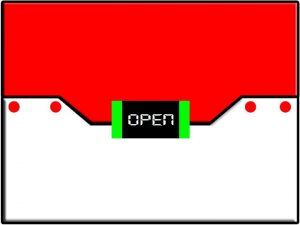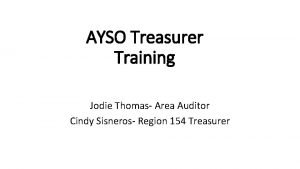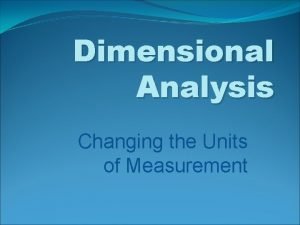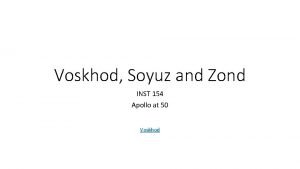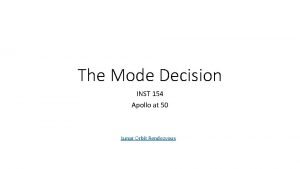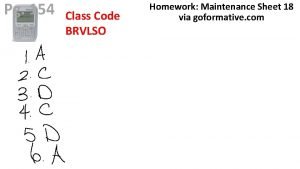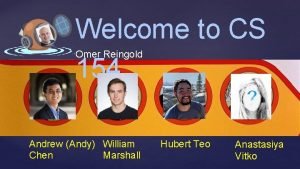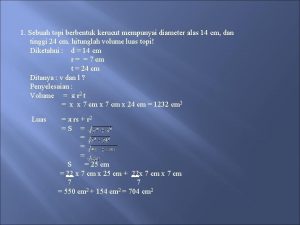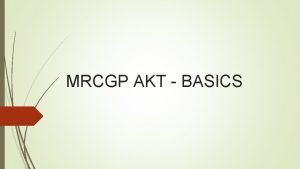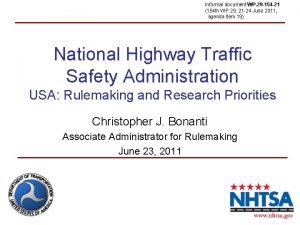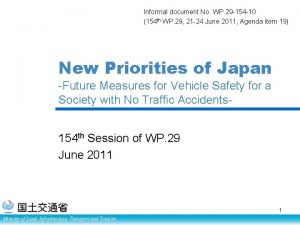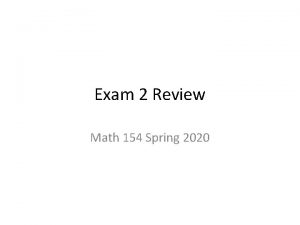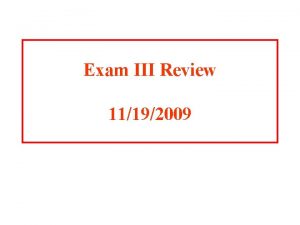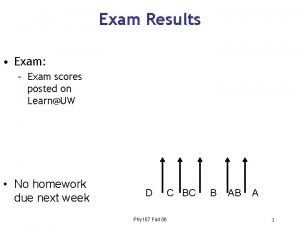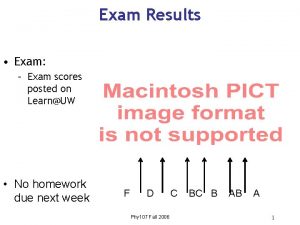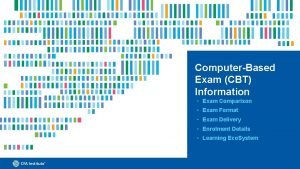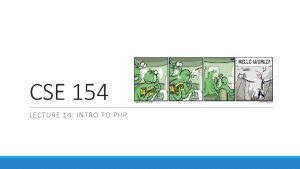Exam I Review CS 154 Intro to Computer
























![Carngie Mellon Filter Example int filter[4]; int apply_filter(int* in) { int i; int x Carngie Mellon Filter Example int filter[4]; int apply_filter(int* in) { int i; int x](https://slidetodoc.com/presentation_image_h/0bd8182d4b6f957b267fd403117877d8/image-25.jpg)



- Slides: 28

Exam I Review CS 154: Intro to Computer Systems Prof Chien Lecture 14 CMSC 15400 1

Exam 1 Logistics ¢ Covers materials through Today’s Lecture, Lecture #14 (Review) November 4 th, Monday, 7 pm-8: 30 pm, KPTC (Kersten Physics Teaching Center) Room 106 ¢ Exam Logistics – closed everything ¢ § Can bring one handwritten sheet of paper § x 86 instruction list will be on the exam paper § https: //www. classes. cs. uchicago. edu/current/15400 -1/154 -exam 1 cheatsheet. pdf Review Session, Saturday 3 -5 pm, Crerar 346 ¢ SDS students only: see email from Daniar Kurniawan (daniar@uchicago. edu) ¢ CMSC 15400 2

Exam I Topics ¢ Representation of Numbers ¢ Integer Arithmetic ¢ What is Architecture ¢ Basic x 86 -64 instructions ¢ Control Flow ¢ Procedures ¢ Arrays, Structs, Unions ¢ Memory Hierarchy and Caching CMSC 15400 3

Memory Organization Addresses specify byte locations § Address of first byte in word § Addresses of successive words differ by 4 (32 -bit) or 8 (64 -bit) 64 -bit Words Addr = 0000 ? ? Addr = 0008 ? ? CMSC 15400 Bytes Addr. 0000 0001 0002 0003 0004 0005 0006 0007 0008 0009 0010 0011 0012 0013 0014 0015 4

Byte Ordering ¢ How should bytes be ordered in memory? § Little Endian: Least significant byte has lowest address § Big Endian: Least significant byte has highest address int x = 0 x 01234567 Big Endian Little Endian short a[] = {0 x 0123, 0 x 4567} Big Endian 0 x 00 0 x 01 0 x 02 0 x 03 01 23 45 67 0 x 00 0 x 01 0 x 02 0 x 03 67 45 23 01 0 x 00 0 x 01 0 x 02 0 x 03 01 23 45 67 a[0] = 0 x 0123 ((char*)a)[1] = 0 x 23 Little Endian 0 x 00 0 x 01 0 x 02 0 x 03 23 01 67 45 23 01 a[0] = 0 x 0123 ((char*)a)[1] = 0 x 01 CMSC 15400 5

Encoding Integers Unsigned Two’s Complement “Sign” Bit ¢ Sign Bit § For two’s complement, most significant bit indicates sign 0 for nonnegative § 1 for negative § But it is NOT the case that changing the sign bit merely changes the sign of the represented value § CMSC 15400 6

Bits, Bytes & Integers ¢ Know how to do basic bit operations § Shifting, addition, negation, and, or, xor, etc. ¢ If you have w bits § What are the largest/smallest representable signed numbers? § What are the largest/smallest representable unsigned numbers? § What happens to the bits when casting signed to unsigned (and vice versa)? Distinguish between logical and bitwise operators (e. g. , & vs &&) ¢ When does (signed, unsigned) overflow happen? ¢ Bit-level behavior is the same for signed and unsigned. ¢ CMSC 15400 7

Computer Architecture The architecture is the interface between software and hardware State - contents of memory imull Hardware xorl (Processor + Memory) movq leaq (Note: different architectures may have different kinds of memory) Methods - change memory CMSC 15400 8

Instruction Set Elements Operations ¢ Condition codes and conditional jumps ¢ Addressing modes for Memory ¢ Procedure call/return ¢ ¢ + relationship to C source code CMSC 15400 9

Software View of Architecture State CPU PC ALU ¢ Registers Condition Codes Addresses Data Instructions Memory Object Code Program Data OS Data Stack Programmer-Visible State § PC: Program counter § Address of next instruction § Called RIP in x 86 -64 § Register file § Heavily used program data § Condition codes § Store status information about most recent arithmetic operation § Used for conditional branching CMSC 15400 Heap § Memory § Byte addressable array § Code, user data, (some) OS data § Includes stack used to support procedures 11

A Very Simple Program (1+2 = 3, stored at 0 x 11 c) 0 x 01 Address 0 x 124 0 x 02 0 x 120 0 x 11 c %rax 0 x 124 0 x 118 %rdx 0 x 120 0 x 114 %rcx 0 x 11 c 0 x 110 ALU %rbx 0 x 108 %rsi 0 x 104 %rdi 0 x 100 %rsp %rbp CMSC 15400 0 x 10 c 0 x 104 movq addq movq (%rax), %rbx (%rdx), %rbx, (%rcx) 12

A Very Simple Program (1+2 = 3) 0 x 01 Address 0 x 124 0 x 02 0 x 120 0 x 11 c %rax 0 x 124 0 x 118 %rdx 0 x 120 0 x 114 %rcx 0 x 11 c 0 x 110 %rbx 0 x 01 ALU 0 x 108 %rsi 0 x 104 %rdi 0 x 100 %rsp %rbp CMSC 15400 0 x 10 c 0 x 104 movq addq movq (%rax), %rbx (%rdx), %rbx, (%rcx) 13

A Very Simple Program (1+2 = 3) 0 x 01 Address 0 x 124 0 x 02 0 x 120 0 x 11 c %rax 0 x 124 0 x 118 %rdx 0 x 120 0 x 114 %rcx 0 x 11 c 0 x 110 %rbx 0 x 03 ALU 0 x 108 %rsi 0 x 104 %rdi 0 x 100 %rsp %rbp CMSC 15400 0 x 10 c 0 x 104 movq addq movq (%rax), %rbx (%rdx), %rbx, (%rcx) 14

A Very Simple Program (1+2 = 3) 0 x 01 0 x 124 0 x 02 0 x 120 0 x 03 0 x 11 c %rax 0 x 124 0 x 118 %rdx 0 x 120 0 x 114 %rcx 0 x 11 c 0 x 110 %rbx 0 x 03 ALU 0 x 108 %rsi 0 x 104 %rdi 0 x 100 %rsp %rbp CMSC 15400 0 x 10 c 0 x 104 movq addq movq (%rax), %rbx (%rdx), %rbx, (%rcx) Address 15

“For” loop example int array_mul( int* A, int* B, long n){ int val = 0; int i; for (i = 0; i != n; i++){ val += A[i]*B[i]; } return val; } CMSC 15400 array_mul: movq $0, %rax movq $0, %rcx jmp. L 2. L 3: movl (%rdi, %rcx, 4), %r 8 d imull (%rsi, %rcx, 4), %r 8 d addl %r 8 d, %eax addq $1, %rcx. L 2: cmpq %rcx, %rdx jne. L 3. L 4: ret 16

Assembly: Basics, Loops ¢ ¢ Recognize common assembly instructions Understand how different control flow is turned into assembly § For, while, if-else, etc ¢ Be very comfortable with pointers and dereferencing § The use of parens in mov commands. %rax vs. (%rax) § The options for memory addressing modes: § D(Rb, Ri, S) § leaq vs. movq § CMSC 15400 17

x 86 -64/Linux Stack Frame ¢ Caller Stack Frame § Return address Pushed by call instruction § Arguments for this call (optional) § ¢ Caller Frame Argument build (Optional) Return Addr Callee Stack Frame § Saved register context § Local variables If can’t keep in registers § Arguments for function about to call (optional) Callee Frame Stack pointer %rsp CMSC 15400 Saved Registers + Local Variables Argument build (Optional) 18

Carnegie Mellon x 86 -64 Linux Register Usage #1 ¢ %rax § Return value § Also caller-saved § Can be modified by procedure ¢ %rdi, . . . , %r 9 § Arguments § Also caller-saved § Can be modified by procedure ¢ Return value Arguments %r 10, %r 11 § Caller-saved § Can be modified by procedure CMSC 15400 Caller-saved temporaries %rax %rdi %rsi %rdx %rcx %r 8 %r 9 %r 10 %r 11 19

Carnegie Mellon x 86 -64 Linux Register Usage #2 ¢ %rbx, %r 12, %r 13, %r 14 , %rbp § Callee-saved § Callee must save & restore ¢ %rsp Callee-saved Temporaries § Special form of callee save § Restored to original value upon exit from procedure CMSC 15400 Special %rbx %r 12 %r 13 %r 14 %rbp %rsp 20

Assembly – Stack ¢ How arguments are passed to a function? ¢ How does a function pass the return value? ¢ How these instructions modify stack § § cs 154 call ret pop push 21

Carngie Mellon Array Access § Understand how in assembly, a logical 2 D array is implement as a 1 D array, using the width of the array as a multiplier for access CMSC 15400 22

Carngie Mellon Memory Hierarchy and Locality ¢ Cache: A smaller, faster memory that acts as a staging area for a subset of the data in a larger, slower memory (DRAM) § For each k, the faster, smaller device at level k serves as a cache for the larger, slower device at level k+1. ¢ Why do memory hierarchies work? § Because of locality, programs tend to access the data at level k more often than they access the data at level k+1. § Thus, the storage at level k+1 can be slower, and thus larger and cheaper bit. CMSC 15400 23

Carngie Mellon Cache Basics E = 2 e blocks per set • Locate set • Check if any block in set has matching tag • Yes + block valid: hit • Locate data starting at offset Address of word: address of word: m bits t bits S = 2 s sets tag s bits b bits set block index offset data begins at this offset v valid bit CMSC 15400 tag 0 1 2 B-1 B = 2 b bytes per cache block (the data) 24

Carngie Mellon Cache Basics ¢ Block Placement: § Where can a block be placed in the cache? ¢ Block Identification: § How a block is found if it is in the cache? ¢ Block Replacement: § Which block should be replaced on a miss? ¢ Write Strategy: § What happens on a write? ¢ First example of microarchitecture § What is microarchitecture and how is it different from architecture (ISA)? CMSC 15400 25
![Carngie Mellon Filter Example int filter4 int applyfilterint in int i int x Carngie Mellon Filter Example int filter[4]; int apply_filter(int* in) { int i; int x](https://slidetodoc.com/presentation_image_h/0bd8182d4b6f957b267fd403117877d8/image-25.jpg)
Carngie Mellon Filter Example int filter[4]; int apply_filter(int* in) { int i; int x = 0; for(i = 0; i < 4; i++) { x += in[i]*filter[i]; } return x; } CMSC 15400 apply_filter: movq. L 2: movl imull addq cmpq jne ret $0, %rax $0, %rdx (%rdi, %rdx, 4), %ecx filter(, %rdx, 4), %ecx, %eax $1, %rdx $4, %rdx. L 2 26

Carngie Mellon Address Trace Address %rdi 0 x 10 filter 0 x 00 0 x 04 0 x 08 0 x 0 C movl imull (%rdi, %rdx, 4), %ecx filter(, %rdx, 4), %ecx 0 x 10 0 x 14 %rdx i filter(, %rdx, 4) &filter[i] (%rbx, %rdx, 4) &in[i] 0 0 x 00 0 x 10 1 0 x 04 0 x 14 2 0 x 08 0 x 18 3 0 x 0 C 0 x 1 C CMSC 15400 0 x 18 0 x 1 C 27

Carngie Mellon Cache Performance Analysis ¢ Derive memory traces from assembly § You need to know assembly, recognize pointer references (both read and write), recognize loops, function calls, etc. ¢ For each access, hit or miss? § You need to know the basics of caching ¢ If cache performance is not good (e. g. , low hit rate), how can you make it better? § You need to know the tradeoffs of different cache designs: bigger cache? Higher associativity? Larger block size? CMSC 15400 28

Carngie Mellon Exam I Topics ¢ Representation of Numbers ¢ Integer Arithmetic ¢ What is Architecture ¢ Basic x 86 -64 instructions ¢ Control Flow ¢ Procedures ¢ Arrays, Structs, Unions ¢ Memory Hierarchy and Caching CMSC 15400 29
 Ap gov final review
Ap gov final review Book review intro
Book review intro Unit 1 study guide government
Unit 1 study guide government Efrona
Efrona Cs 154 uchicago
Cs 154 uchicago Cse 154
Cse 154 Cse 154
Cse 154 Cs 154 sjsu
Cs 154 sjsu Surah al baqarah 154-157
Surah al baqarah 154-157 Ordinul 154 din 2004
Ordinul 154 din 2004 Diketahui volume suatu balok 154 cm
Diketahui volume suatu balok 154 cm Senet 154
Senet 154 Cr part 154
Cr part 154 Jodie thomas
Jodie thomas A person's weight is 154 pounds convert this to kilograms
A person's weight is 154 pounds convert this to kilograms Inst-154
Inst-154 Inst-154
Inst-154 Homework 154
Homework 154 Anastasiya vitko stanford
Anastasiya vitko stanford Diameter alas sebuah kerucut 10 cm
Diameter alas sebuah kerucut 10 cm World history spring final exam review answers
World history spring final exam review answers Exam review template
Exam review template Spanish 2 final exam review
Spanish 2 final exam review Spanish 1 review packet
Spanish 1 review packet Pltw human body systems final exam
Pltw human body systems final exam Poe practice test - materials answer key
Poe practice test - materials answer key Gp akt sample questions
Gp akt sample questions Ied final exam review
Ied final exam review Hbs eoc practice test
Hbs eoc practice test



